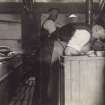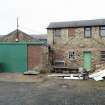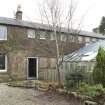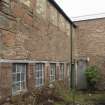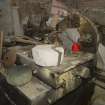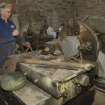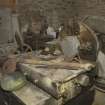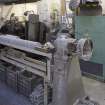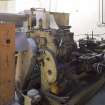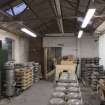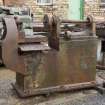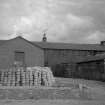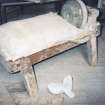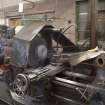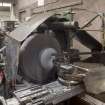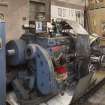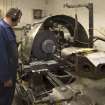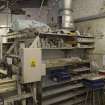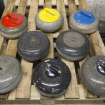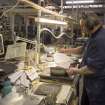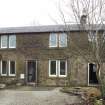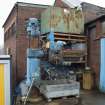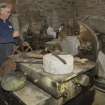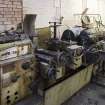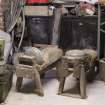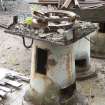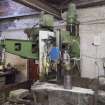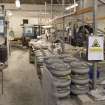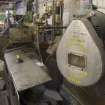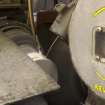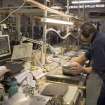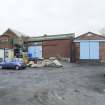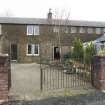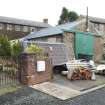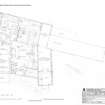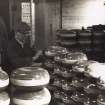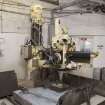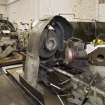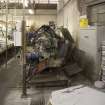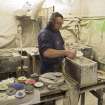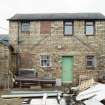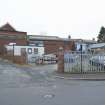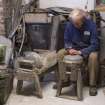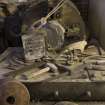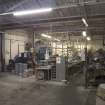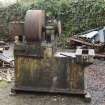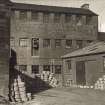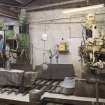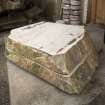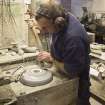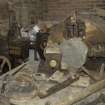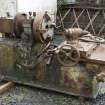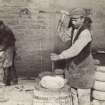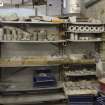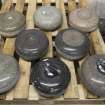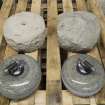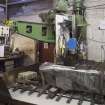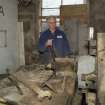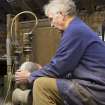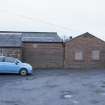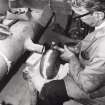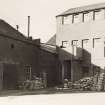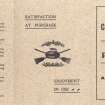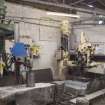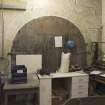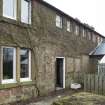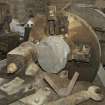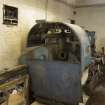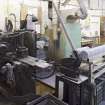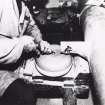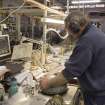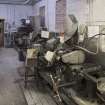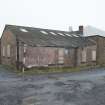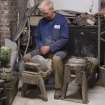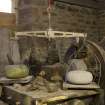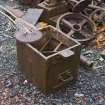Pricing Change
New pricing for orders of material from this site will come into place shortly. Charges for supply of digital images, digitisation on demand, prints and licensing will be altered.
Mauchline, 9 Barskimming Road, Kay's Curling Stone Factory
Factory (20th Century)
Site Name Mauchline, 9 Barskimming Road, Kay's Curling Stone Factory
Classification Factory (20th Century)
Canmore ID 320218
Site Number NS42NE 33.01
NGR NS 49754 27099
Datum OSGB36 - NGR
Permalink http://canmore.org.uk/site/320218
First 100 images shown. See the Collections panel (below) for a link to all digital images.
- Council East Ayrshire
- Parish Mauchline
- Former Region Strathclyde
- Former District Cumnock And Doon Valley
- Former County Ayrshire
Kays of Scotland, Curling Stone Manufacturers, 9 Barskimming Road, Mauchline, East Ayrshire (NS42NE 33.01)
With a manufactory originally dating from 1851 Kay's of Mauchline, Ayrshire are unique in the UK for the manufacture and export of curling stones to venues around the World making high precision curling stones for international competition and club use. Curling is a sport in which teams of players slide specially shaped stones over sheet ice to a target. It is related to bowls, boule and shuffleboard and has a long and complicated history with several countries, including Scotland, claiming to have invented it.
The granites used in the production of curling stones at Kay's come from Ailsa Craig island (NX 019 997) located in the Firth of Clyde some 10 miles (16km) west of Girvan, South Ayrshire. Kay's have been involved in providing curling stones for every Winter Olympics since Chamonix in 1924 and has
produced all of the stones for the last five, and the upcoming Sorchi, Winter Olympic Games.There are four broad stages in the making of a curling stone: cutting, shaping, polishing and finishing for which special coring machines and saws (for cutting), lathes (for shaping and drilling) and polishing wheels and shot-blasting machines for finishing are packed into a relatively small floor area. Despite being mechanised for the main cutting and shaping of the curling stone, the workforce is highly skilled and there is a lot of hands-on refining of the curling stones throughout the manufacturing process.
Visited by RCAHMS (MMD) 2012.
Note (30 November 2012)
This curling stone manufactury relocated to this site in 1911. The building (now modfified) was originally a Mauchline Box maker's workshop.
Information noted by MMD from J Wyllie, owner, 30 November 2012.
Photographic Survey (29 January 2013 - 30 January 2013)
RCAHMS surveyed Kay's of Scotland, Curling Stone Manufacturers in Mauchline, East Ayrshire as part of its Industrial Survey programme. The aim was to record the buildings (former Box Works) and process of making curling stones. This is a unique site in the UK.
Information from RCAHMS (MMD), February 2013.
Field Visit (2013)
Kays of Scotland, 9 Barskimming Road, Mauchline, East Ayrshire,Curling Stone Manufacturers
1. Background
Kay's of Mauchline manufacture and export 'the unique Ailsa Craig curling stones to venues around the World' - professional, high precision curling stones for international competition and club use.(1) The Ailsa Craig Blue Hone and Common Green Ailsa granites (and Ailsa Craig Red Hone), used in the production of curling stones at Kay's, come from Ailsa Craig island (NX 019 997). Ailsa Craig covers 219.69 acres and is located in the Firth of Clyde some 10 miles (16km) west of Girvan, South Ayrshire. Between 1500 and 2000 tons of granite is harvested as required (2) and arrives at a holding yard in Mauchline (Ramsay and Jackson agricultural implement makers). Kays are the only licensee to harvest granite from Ailsa Craig.
The curling stone manufactory relocated to this site in 1911 from a water-powered site at The Haugh (NS49763 25324) (3) 'Curlingstone Mill' (4) which was founded in 1851. Kay's have been involved in providing curling stones for every Winter Olympics since Chamonix in 1924 and has produced all of the stones for the last five Winter Olympic Games.
Kay's factory is currently on the site of the former Davidson, Wilson and Amphlet (later Wilson, Amphlet and Co.) Box Manufacturers. (5) The 'fancy wood' trade was important to Mauchline indeed, Mauchline Ware is now highly prized especially that produced by W and A Smith's Mauchline Boxware Factory off New Road (now Kilmarnock Road), Mauchline.
2. Buildings (see DC51403)
Kays took over the Victoria Box Works from Wilson, Amphlet and Co. Box Manufacturers before the First World War. (6) The current curling stone site consists of much altered buildings built between 1857 (7) and 1895. By 1896 there are three roofed buildings shown at NS49745 27101 (now a storage area), NS49763 27096 (the three storey building which only parts of the north and south wall survive) and NS 49767 27072 (unidentified, demolished). (8) Vertical aerial photography from 1946 (9) shows the site prior to post 1949 changes. It shows four buildings on the present site including: the Rough Out Shed (NS 49745 27101); the long, north west/south east oriented three-storey and two-storey range which partially survives (centred at NS 49773 27081), and the north building (former Turning Shed) which now houses the Giftware section (DP150528). By 1958, an additional range has been added at NS 49757 27087 (10) and the courtyard at NS49753 27103 has been covered. By 1978, the buildings had taken on their current layout. (11)
A photograph taken after 1949, but before 1960 (DP149659), shows the original layout of the Mauchline Box -making factory with a three storey masonry building with an extending two-storey range to the east. The first and second floors of the west portion of the original range were taken down in c.1960 (12, and see DC51403), with only a partial south wall and north wall remaining (the north wall is visible in DP150525). The open courtyard at NS49753 27095 was covered over and the south area of the Main Workshop area created (where lathe 1, lathe 2 and Vertical Corers now sit).The north portion of the Box-making factory was removed and replaced by a brick-built building which extended further north and subsumed the smaller courtyard at NS49752 27106, between the Rough Out Shed and the Turning Shed (the area that now houses the giftware machinery).
3. Process (see DC51403)
Cutting
The large Common Ailsa boulders are sent from Mauchline to Aberdeen for sawing into 0.15m thick slabs. These cut slabs are returned by road to Kays's factory in Mauchline, where they are checked. The slabs are marked out with a stencil (DP150521) as a guide for the operator of the Vertical Corer (DP150466) which cuts the 50lb 'cheeses' or rough outs from each prepared slab. The Vertical Corer 1 drills the granite slab, using the stencil outlines to guide the cutting tool or corer. After 30-35 minutes, a 'cheese' or roughed out stone weighing 50 lbs (DP150474) is sent to Lathe no. 2 where the pocket for the 'Ailsert' (Blue Hone insert) is cut into the rough curling stone. The Ailsert is then inserted into 'cheese' or body of rough stone with epoxy resin (DP150543). The Ailserts are cut from large Blue Hone boulders by Vertical Corer No.2 (DP150465).
Shaping
The 'cheese' or rough out with its Ailsert is then sent to Lathes 3 and 1 for rough shaping by cutting 'shoulders' and smoothing off both faces of the stone (DP150470). The stone is then manhandled to Lathe 4 for fine shaping of final profile which produces the final basic shape by the cutting of the cup into the Ailsert or body of the Common Ailsa stone, refining the running edge and the shoulders (DP150518). The stone is now 90% complete. The almost complete stone needs further profile refining. It is placed in Lathe 5 for the shaping of the striking band. The third line is added by hand after this ensuring that curlers know whether it is the top or bottom of the curling stone. This is important regarding wearing as this affects performance.
Polishing
The stone is then hand polished on the Polishing Machine, finished with a hand- held electric polisher using diamond studded disks (DP150480). Tin oxide and bespoke 'home-made' tools are used including a polishing hand-held stone and a long handled artefact with a shaped end used to bring up the high polish of the body of the stone (DP150497). There is also a pillar drill used to create the countersink (DP150480). The stone is then finished in the shot blast booth to produce the rough striking band. This ensures that there is a 'rough' striking surface between curling stones during a match.
Finishing
Running Edge Quality Control matches stones using emery paper 'prints' to make a rubbing of the running edge (DP150491-4). These prints go to the main office for double check measuring and checking. If stone passes checks, it is engraved with its number and sent onto customer. Handles are put on by customer. (13)
4. Equipment (as of January 2013; see DC51403 for layout of Main Workshop, Rough Out Shed and Giftware areas)
4.1 Main Workshop: Vertical Corer no. 2, Asquith vertical drill. jig with modern computerised drill attached (Dutch made).Produces ailsert cores. Coring (15-20 minutes for one core). Drilled boulder is taken outside to be hammered to remove cores. See DP150468
4.2 Main Workshop: Vertical Corer no.1, Asquith vertical drill. Rough out or 'cheese' cutting 30-35 minutes per 50lb rough or 'cheese' core. See DP150465
4.3 Main Workshop: Landis Saw, Sawing ailserts into 1 inch/ 25mm disks,'Landis' for sawing ailserts into 1 inch/ 25mm disks after cut and removed from boulder cored by Vertical Corer no. 2. Takes 2-3 minutes to saw an ailsert from a core. See DP150478
4.4 Main Workshop: Lathe 1, Herbert 9C/30. Rough shaping and Final rough finish 164mm. Similar function to Lathe 3. See DP150470
4.5 Main Workshop: Lathe 2, Herbert 9C/30. Pocket cut for ailsert. Ailsert inserted into 'cheese' or body of rough stone with epoxy resin. Inserting central drill hole for handle. Machines 2 and 3 are tooled up to duplicate ailsert cutting and drilling. See DP150475
4.6 Main Workshop: Lathe 3, Herbert 9C/30 capstan or turret lathe. Undertakes rough shaping. Undertakes rough shaping (shoulders) and produces the Final Rough Finish 134mm. Inserting central drill hole for handle. See DP150477
4.7 Main Workshop: Lathe 4, Herbert 9C/30. Fine shaping of final profile. Final diamond finish 155mm, final basic shape, cup, running edge and shoulders refined (90% complete stone). See DP150518
4.8 Main Workshop: Lathe 5, Lang Lathe. Banding lathe striking band shaper. See DP150524
4.9 Main Workshop: Polishing Machine 1. Polishing. Part hand polishing and machine polishing. 'Shiner' (my name for this) home-made wooden hafted implement with curved end used to polish the cup of the curling stone. It is kept wet, tin oxide applied and applied with pressure by the polisher. A polishing stone is used first by hand, then Tin oxide used and each stone takes 20-30 minutes using a 'shiner' which puts the gloss on the ailsert Blue Hone cup area and shoulders of the stone. The stone is then finished with a hand held polisher using diamond studded disks. There is also a pillar drill used to create the countersink (Elliott Progress, in background). See DP150480; D150496-7; DP15048
4.10 Main Workshop: Sandblaster booth. Striking Band applied. This is for aesthetic reasons and to roughen the striking band to reduce chipping.
Main Workshop: Hand finishing Area. Edge QC to match stones using emery paper 'prints' to make a rubbing of the running edge. This also goes to the main office for double check measuring and checking. If stone passes checks, it is engraved with its number and sent onto customer. Handles are put on by customer. See DP150491-4
4.11 Main Workshop: Storage space. Rough out cores stored here. Then moved to Lathe 2 for ailsert pocket cutting. See DP150474
4.12 Rough Out Shed: Old roughing machine Formerly carried out the same function as Lathes 1 and 3. Built by Barclay's of Kilmarnock. Disused. See DP150512-17
4.13 Giftware Production: Lathe 9, Herbert No.5 Senior lathe. Takes the small cores and saws into blanks. There are 3 sizes of curling stone giftware. See DP150525
4.14 Giftware Production: Grinder. NI Machine. Tungsten tipped disks for general grinding.
4.15 Giftware Production: Lathe 7, Herbert No.5 Senior lathe. Drills holes in the middle of the blanks and for undercutting machine for larger size curling stone giftware. See DP150526
4.16 Giftware Production: Lathe 6, Ward 3DB Capstan or turret lathe. Undercuts to produce circular pocket for metal finishings. Made by H W Ward and Co. Worcester, England. See DP150524
4.17 Giftware Production: Lathe 8, Herbert No.5 Senior lathe. General Work. See DP150527
4.18 Giftware Production: Six Spindle Machine. Shapes the drilled and undercut blanks. See DP150522
4.19 Giftware Production: BSA Tools Lapping Machine Was used for general polishing of flat giftware such as coasters. Not in use. See DP150551
4.20 Giftware Production: Polishing Machine, C Winning Limited, Birmingham. Removes rough edges from giftware curling stone striking band and handle disk insert. See DP150523
4.21 Giftware Production: Lacquering Spray Booth. Finished giftware put onto rods and placed on spray booth for spray gun lacquering by hand. Then checked and striking band applied in the sand blaster in the main workshop used for full size curling stones. See DP150552-3
4.22 Giftware Production: Store. Area where rough out giftware stored. See DP150482
4.23 Exterior: Quenching Tank for cutting tools and tongs. From old smithy (formerly in Rough Out Shed). Date from 1940s-1960s. See DP150548
4.24 Exterior: Cupping Machine. Cut cups into top and bottom of curling stones. Now carried out by Lathes 1 and 3. Built by Andrew Barclay of Kilmarnock. Disused since 1980s. See DP150547
4.25 Exterior: Grinding Machine. Finishing - now carried out by Lathe 4. Built by Andrew Barclay of Kilmarnock. Disused since 1980s. See DP150546
4.26 Exterior: Polishing Machine. Date unknown. See DP150545
4.27 Exterior: Turning Machine. Functions now carried out by Lathes 1 and 3. Built by Andrew Barclay of Kilmarnock. Disused since 1980s. See DP150544.
Visited and recorded by RCAHMS (MMD), 28-30 January and May 2013.
Notes
(1) Kay's website http://www.kaysofscotland.co.uk: retrieved 4 February 2013.
(2) http://www.kaysofscotland.co.uk, retrieved: 4 February 2013.
(3) The buildings are shown as Corn Mill and Saw Mill: OS 25-inch 1st Edition map, Ayrshire, 1860, sheet XXVII.12 (Mauchline); 'Curlingstone Mill' : OS 25-inch 2nd Edition map, Ayrshire, 1896 and 1909, sheet 28.12.
(4) http://www.ayrshirehistory.com/mauchline_boxworks.htm:, retrieved 14 May 2013.
(5) OS 25-inch 2nd Edition map (Ayrshire, 1896 and 1909, sheet 28.12).
(6) In c.1911: info from Mr James Wyllie, 28 January 2013.
(7) OS 25-inch 1st Edition map, Ayrshire, 1860, sheet XXVIII.8 (Mauchline), where current buildings shown as garden plots behind the now demolished 'Glenlee'; http://www.ayrshirehistory.com/mauchline_boxworks.html: retrieved 14 May 2013 states that it was built in 1859.
(8) OS 25-inch 2nd Edition map, Ayrshire, 1896, sheet 28.08.
(9) RAF Verticals 106G/SCOT/UK/86, 10/5/1946, frames 4248-9.
(10) RAF Verticals 58/RAF/2712, 11/2/1958, frames F21 0026-0028.
(11) OS 78 167, 1/10/78, frames 018-020.
(12) Information from Mr James Wyllie, 28 January 2013.
(13) Information from Mr James Wyllie, January and April 2013.
Glossary
Ailsert - granite disk inserted into the 'pocket' cut in rough out in Lathe 2
Banding - act of creating the striking band on a curling stone
Countersink - recess cut into curling stone to allow fitting of handle
Cup - the concave areas of a curling stone
Cupping Machine - cutting tools on lathe which cut the cups into the top and bottom of a curling stone; at Kay's this is now done by modern lathes
Curllng - a team game with rules (written down early 19th century) governing the movement of curling stones and players across ice
Curling Stone - cut and polished granite stone of standard weight and design for use in the game of curling
Rough Out Machine - bespoke machine used to begin to shape the curling stone prior to being finished by hand
Rough Out Shed - area where hand hewn curling stone rough was shaped by the Rough Out Machine prior to being finished by hand
Running Edge - the part of the curling stone which comes into contact with the ice; edge of the cup of the curling stone (top and bottom)
Striking Band - area of a curling stone which strikes other curling stones during the game of curling
Acknowledgments
Mr James Wylie, owner, and his colleagues for their time.
Note (5 August 2024)
NS42NE 33.00
NS42NE 33.1
NS 49754 27009 (centred)
This building was constructed in the late 18th century, for making wooden snuffboxes, with so-called 'secret' hinges. It later made other wooden goods, mainly for the tourist trade, such as napkin rings, string holders, and cigarette boxes.
In 1966 the box factory was being used as a store by Andrew Kay & Co, Scotland's only firm of curling stone makers, and world leaders in this field. In the 19th century the wooden 'Mauchline Ware' had a comparable reputation.
Information from JR Hume, Scran 1999-2001 contributor to the JR Hume Collection SCRAN project of industrial images.










































































































